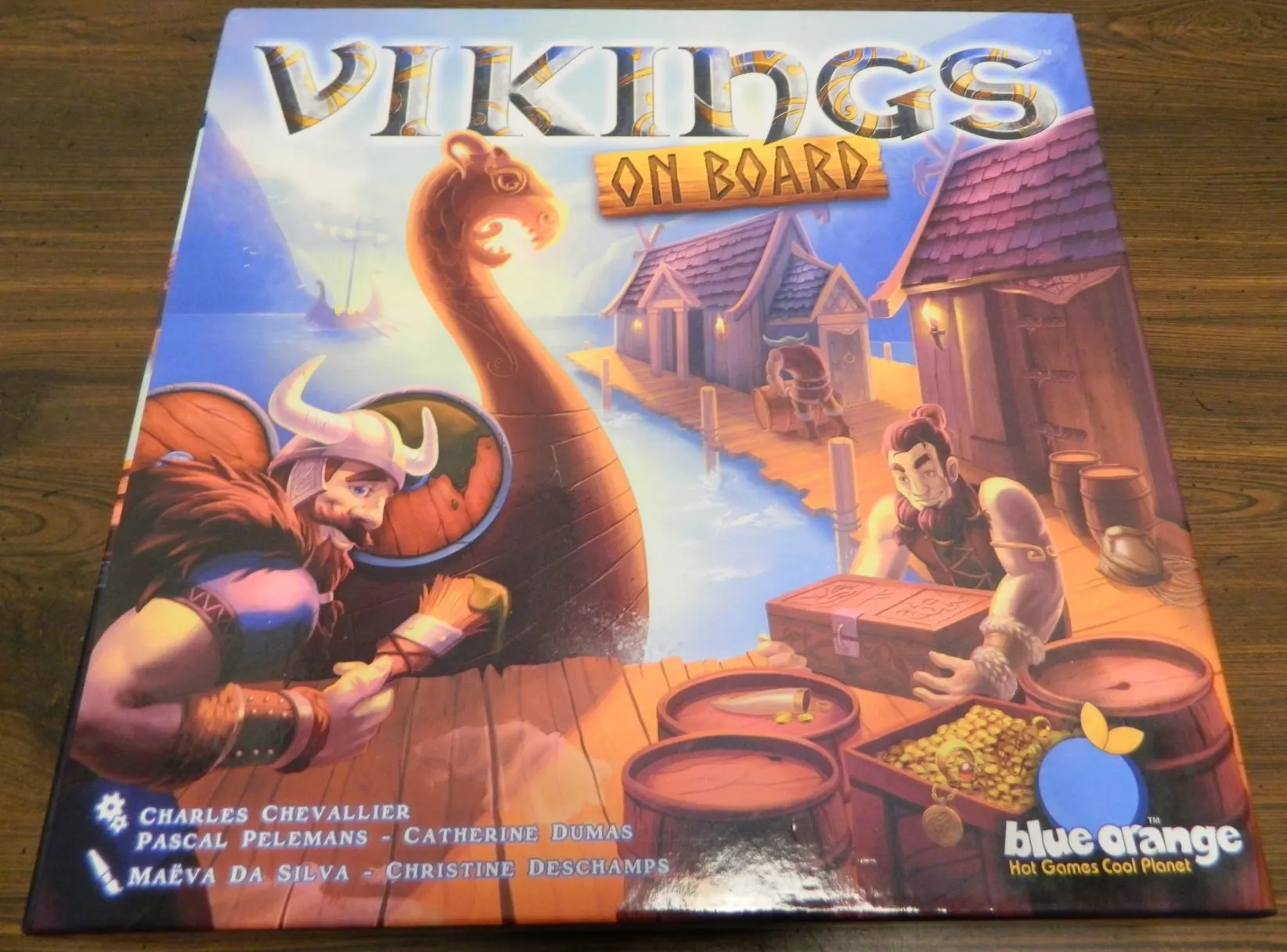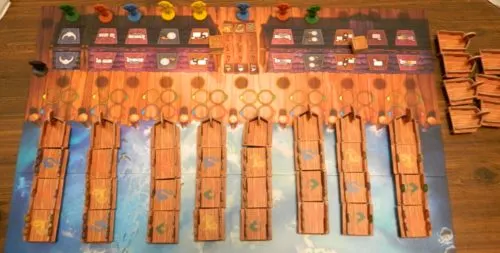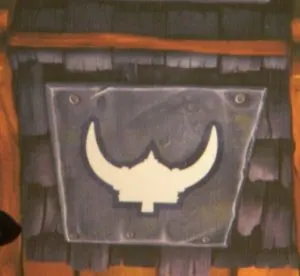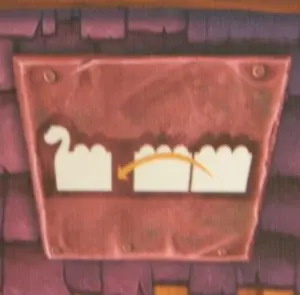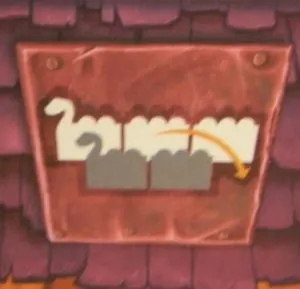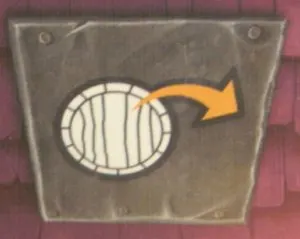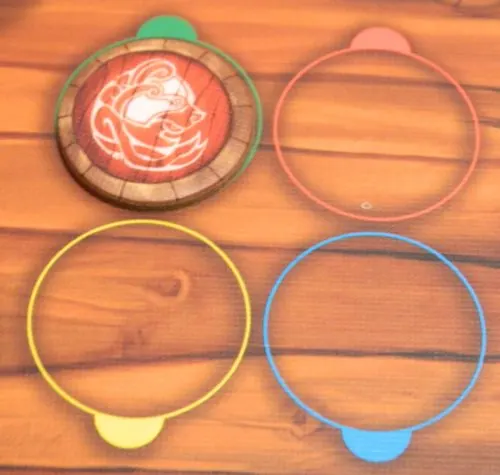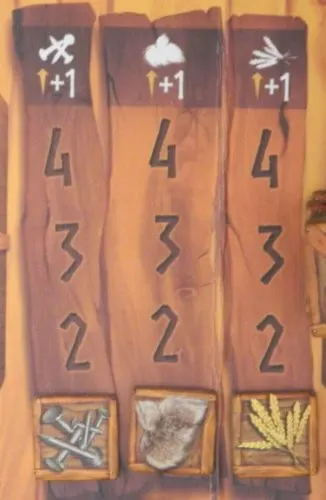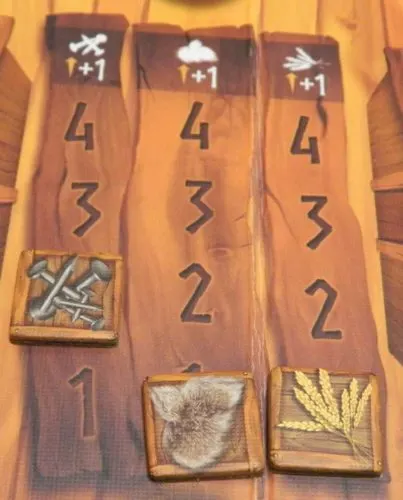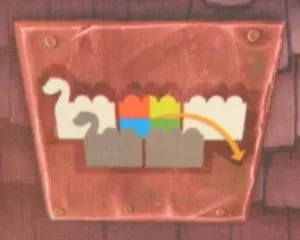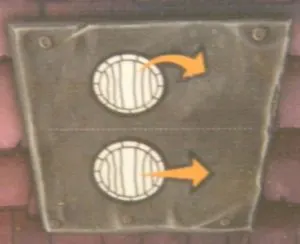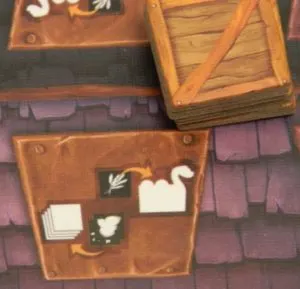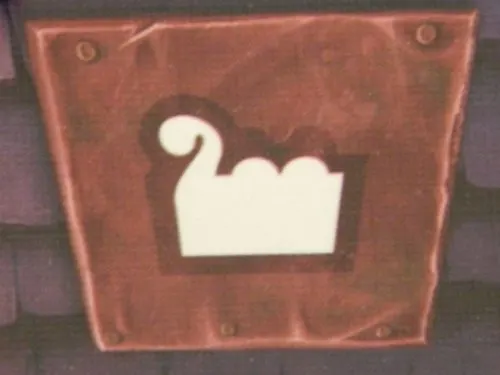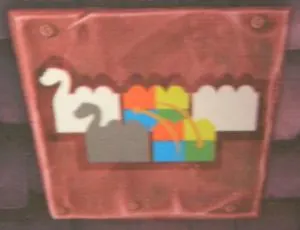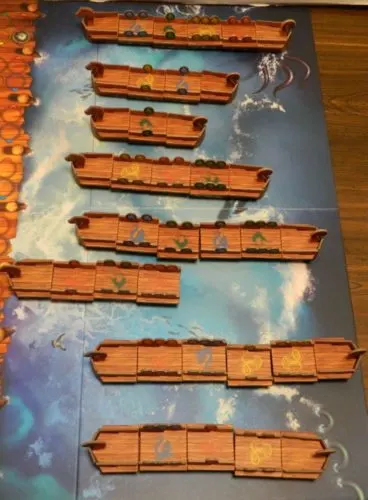Today I am going to take a look at Vikings On Board created by Charles Chevallier (Abyss, Kanagawa), Catherine Dumas, and Pascal Pelemans in 2016. In Vikings On Board you and the other players control your own clan of Vikings who are planning for their next voyage. As the ships are assembled for the voyages you want to maintain control over the most ships in order to receive the most supplies. This leads to all of the clans competing for control over the ships. Which Viking clan will maintain the most control once the ships have set sail? Vikings On Board is an interesting combination of mechanics with great components which leads to a fun game even if it sometimes feels like something is missing.
How to Play Vikings On Board
Setup
- Place the game board in the center of the table.
- Each player chooses a color and takes the following components in their chosen color:
- 1 scoring circle
- 4 gambling tokens
- A number of Viking pieces based on the number of players.
- 2 Players: 4 Vikings
- 3 Players: 3 Vikings
- 4 Players: 2 Vikings
- Determine the starting order for the first round. Take one Viking of each color and mix them up. Randomly draw the Vikings with the first chosen color being letter A and so on. The tokens will be placed in a line as follows depending on the number of players:
- 2 Players: AB BA AB BA
- 3 Players: ABC BCA CAB
- 4 Players: ABCD DCBA
- The leader token is placed on the opposite side of the village from where you placed the Viking tokens.
- Place the seven stern pieces near the Set Sail action space.
- Place the three market value tokens on the lowest space in each section of the market.
- Shuffle the supply tokens face down. Create a stack of seven supply tokens and place them next to the Add 1 space. The remaining eight supply tokens will be placed next to the Take 3, Add 1 space.
- Place the eight ship bow pieces in the harbor next to each space in the harbor.
- Randomly choose three ship body pieces and add them to each bow piece. Only one body piece of each color should be placed in each boat.
Playing the Game
Vikings On Board will be played over seven or more rounds. The turn order for each round is determined by the order of the Viking pieces in the village. The player whose piece is furthest left will go first followed by the next player and so on. Each player will take a number of turns equal to the number of Viking pieces that they have.
On a player’s turn they will pick up their next piece and choose which action they would like to take. They may take any action corresponding to a space that doesn’t already have a Viking on it. When a player has chosen their action they will place their piece on the corresponding space on the side of the village that the leader token is on. The player will then take the corresponding action (see the Space Actions section below).
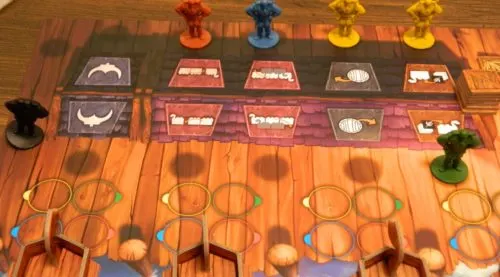
The green player was the first player in this round. They choose the Add 1 action by placing their piece on the corresponding space on the same side of the village as the leader.
The player that controls the next Viking will then take their turn. This continues until all of the Viking pieces have been moved to the side of the village that the leader is on. When all of the pieces have been moved the current round ends.
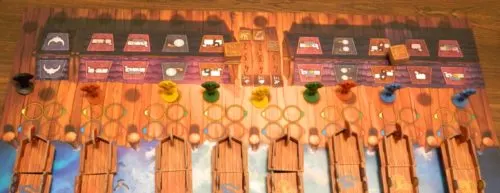
As all of the players have taken their action this round the round has ended. The black leader piece will be moved to the other side of the village and the next round will begin.
If a player chose the Set Sail action this action will now be performed (see the Setting Sail section).
If there is still at least one stern piece remaining the players will play another round. The leader token is moved to the other side of the village and the next round is played in the same way as the previous round.
Setting Sail
Each ship is comprised of three sections. The bow/front of the ship is placed next to the harbor. This part of the ship is where you place the supply tokens that have been added to the ship. Next to the bow are the middle pieces. The ships can have between zero and five middle pieces. These middle pieces feature shields of the different player colors which correspond to the player that chose that color. Finally a ship is completed by adding a stern to the back of the ship.
If during a round one of the players chose the Set Sail action, the players will complete the Setting Sail process before starting the next round. The player who chose the action will have already taken one of the stern sections when they chose the action. The player will choose which ship they would like to complete (can’t be a ship that has already set sail) and place the stern piece to complete the ship. When they have completed the ship they will move it away from the harbor to show that the ship has set sail. When choosing a ship to set sail the following two rules must be followed:
- The ship has to have at least one middle piece.
- The ship has to have at least one supply token.
If none of the available ships fit these rules the player can choose whichever ship they want which hasn’t already set sail.
After a ship sets sail the players will determine who controls the ship. Count up the number of shields of each color on one side of the ship. The number of shields each player has in the boat indicates how much control they have over the boat. The player with the most shields is in “first control”. The player with the second most shields has “second control” and so on. If there is a tie for one of the positions, the player who has a section closer to the harbor will break the tie. In 2-3 player games a color not controlled by one of the players can take one of the control positions.

This ship has set sail with two supply tokens on board, a hide and a metal. The yellow player will take first control as their color has three shields while blue and red have two, and green has one. Second control will go to blue even though they have the same number of shields as the red player since the blue piece is closer to the front of the ship.
After control is determined the supplies on the ship will be handed out. The player with first control will get to choose which supply token they would like to take. They will place their chosen token facedown on their score circle. If there is two or more supply tokens the player in second control will get the next choice. This continues to the third player and so on. If a player has none of their ship parts in the ship they will not get to take any supply tokens. If all of the viable players have taken a token and there are still tokens remaining the first control player will get to take another token. This continues through the control order until all of the supply tokens are taken.
If a non-player color would receive supply tokens the player to the left of the player to take the next supply token will choose which token the non-player will take. This token is removed from the game.
After the ship has set sail and the supply tokens have been given out players will determine whether anyone bet correctly. If a player bet on the color that earned “first control” they will take their betting token and add it facedown to their scoring circle. If a player bet incorrectly the token will remain on the space where it was placed. On a future turn a player can use the Bet/Move A Bet action to move the token to another space.
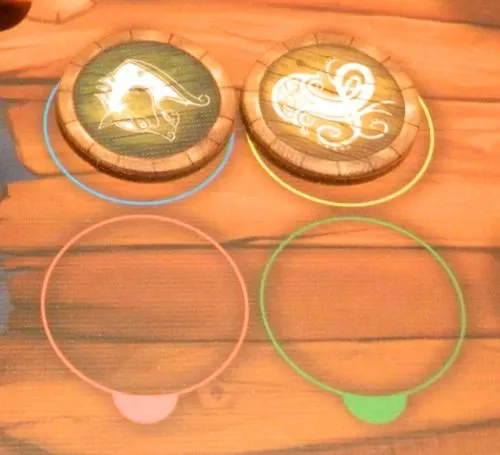
Based on the previous picture the yellow player has first control over the ship. Therefore the yellow player bid correctly so they will get to add their betting token to their scoring circle. The green player bid incorrectly so their token stays on the space. They will have to use the Bet/Move A Bet to move their token to another space.
Space Actions
In Vikings On Board there are a number of different actions that players can take. A player can only choose an action if none of the players have chosen the action yet this round. If possible a player must take the action. All actions can only be applied to ships that have yet to set sail.
First Player: This action gives the player no special actions this round. By choosing this action though the player will get to choose the first action in the next round.
Promote: When a player chooses this action they will move one of the ship pieces of their color to the front of its current ship.
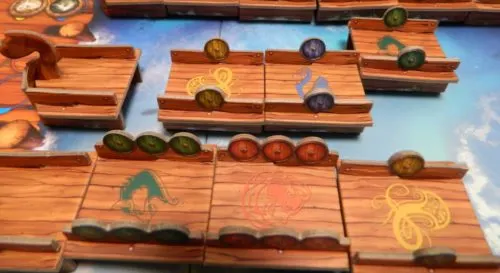
For the top ship the player has decided to take the Promote action. They used the action to move their ship piece to the front of the ship. As all of the players have the same number of shields in the ship the green player will now have the tiebreaker for the ship.
Jump Your Ship: This action has a player move one of their ship pieces from one ship to the back of another ship.
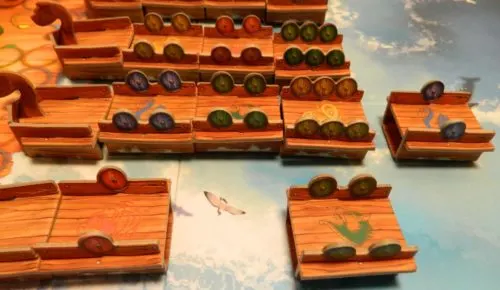
The blue player had a piece in the empty space in the ship along the bottom. As the blue player was currently in third place in that ship they decided to use the Jump Your Ship action to move it to the ship above. This puts the blue player into first control in the new ship.
Bet: The player who chooses this action will take one of the betting tokens from in front of them and choose one of the boats to bet on. They will place their chosen token face down on the circle corresponding to the color that they think will take “first control” when the ship sails.
Add 1: When a player chooses this action they will take the top supply token from the stack next to the space. The player will get to choose which ship to place the token face up on. The only restriction is that it can’t be placed on a ship that has already sailed.
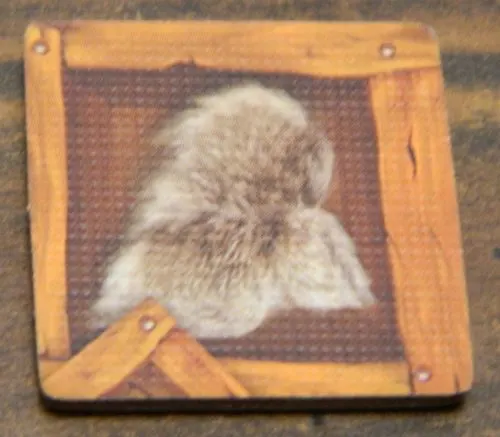
This player choose the Add 1 action. They drew this hide supply token. They will choose which ship they would like to place the supply token on.
Marketplace: The player who chose this action will get to move the value of one of the goods in the marketplace by one. A good’s value can never be lowered and it can’t be raised above four.
Jump Any Ship: This action allows a player to choose a ship piece of any color and move it to the back of another ship.
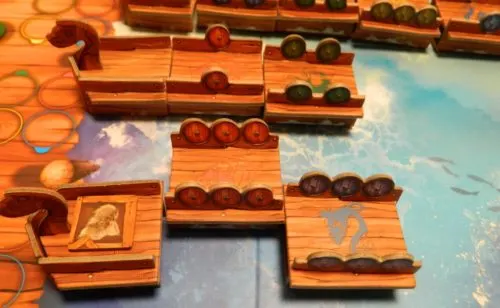
As the blue player is currently not going to receive a supply token from this ship, the blue player has chosen to use the Jump Any Ship action on the red three ship piece moving it to another ship. As the blue player will be the only player with a piece in this ship they will currently have first control over the ship.
Bet/Move A Bet: This action is the same as the Bet action. Instead of placing a betting token you can instead choose to move one of your betting tokens to a different space.
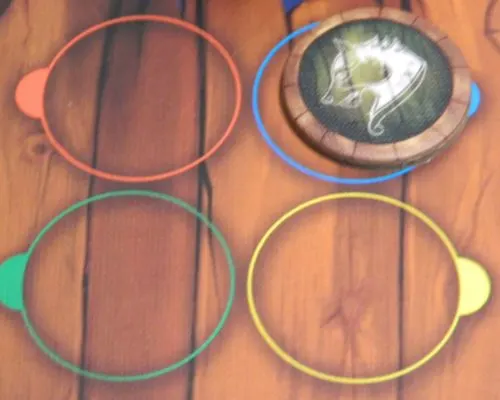
The green player bet on the blue player having first control over this ship. They bet incorrectly as the blue player did not maintain first control over the boat. The green player will use the Move A Bet action to move their betting token to a different ship.
Draw 3, Add 1: When this action is chosen the player will take the top three supply tokens next to the space. They will choose one of the three tokens and place the other two back on the bottom of the stack that they were taken from. The supply token that the player chose will then be placed on the boat of the player’s choice that hasn’t sailed yet.
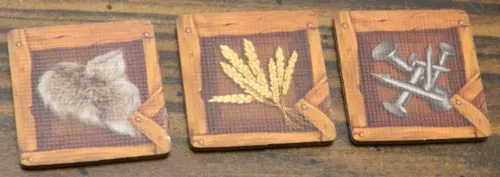
This player has chosen the Draw 3 Add 1 action and has drawn one of each of the three supply tokens. They will choose the token they prefer and return the other two to the bottom of the pile they were taken from. The player will then choose which ship they would like to add the chosen supply token to.
Set Sail: The player who takes this action will take one of the stern pieces and place it in front of themselves. The rest of this action will take place at the end of the round (see the Setting Sail section).
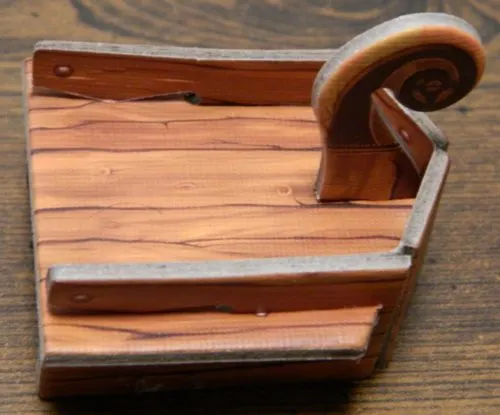
This player chose the Set Sail action so they took one of the stern pieces which they will place on one of the ships that hasn’t set sail yet.
In a two player game when one of the players takes the Set Sail action the other player will get to take a special action. This player will take one of the Vikings piece from one of the colors not being used. This Viking will be placed on one of this player’s boat sections and will stay there for the rest of the game. This Viking piece will count as one additional shield.
Swap Ships: When a player chooses this action they will select two ship pieces of any color. These two ship pieces will switch places.
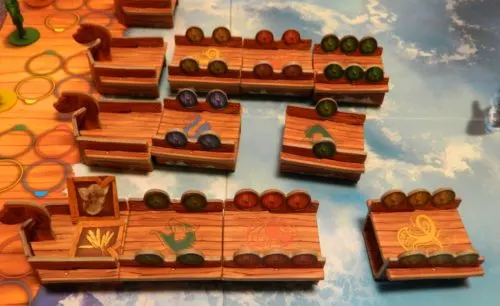
The green player was in third place in the bottom ship as they only had two shields compared to the three shields for the red and yellow player. As there were only two supply tokens the green player wouldn’t have received one of them. Therefore the green player decided to use the Swap Ships action. They chose to swap their one shield piece from the ship above with the yellow three piece from the other ship. The green player will now have three shields in the bottom ship which will tie them with the red player. As the green player has the tiebreaker the green player will currently have first control over the ship.
End of Game
The game will end immediately after the seventh ship has set sail. The eighth ship will not have the opportunity to set sail.
Players will calculate their score by combining the value of the betting tokens and supply tokens that they added to their scoring circle.
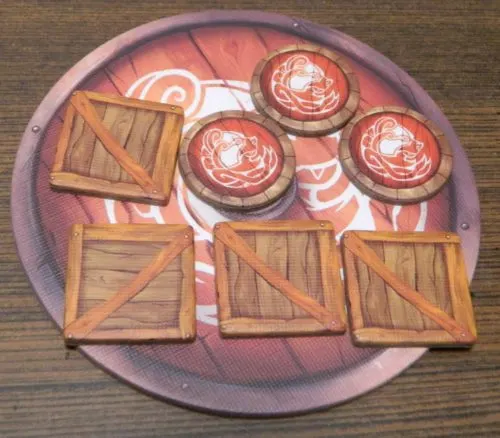
This player received four supply tokens and three betting tokens during the game. They will score points for these tokens.
The betting tokens are worth the value printed on the token.
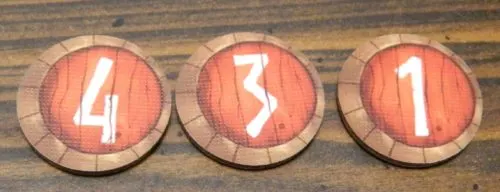
This player successfully placed their four, three, and one betting tokens. They will score eight points for these tokens.
The supply tokens are worth the current value of the corresponding good in the marketplace.
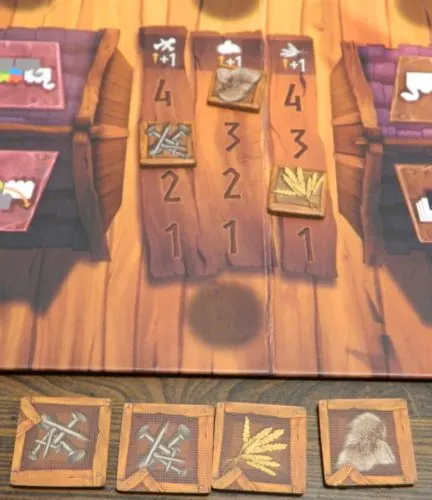
During the game this player collected two metal tokens, one grain token, and one hide token. The player will score six points from the metal tokens (3 * 2), four points from the hide (4 * 1), and two points from the grain (2 * 1).
The player who scored the most total points will win the game. If there is a tie the tied play with the most supply tokens will win. If there is still a tie the tied player with the most points from supply tokens will win. If the tie is still not broken the tied players will share the victory.
My Thoughts on Vikings On Board
Vikings On Board is not the easiest game to describe. The game is a combination of a bunch of different board game genres. This leads to a lot of things that I liked about the game, but there are other things that I didn’t really care for.
Lets begin with the worker placement mechanics. I am a pretty big fan of this genre as I like when games give players a large menu of different actions to chose from. This mechanic really drives Vikings On Board’s gameplay. In order to take any action in the game you need to place one of your Vikings on one of the corresponding spaces. Only one Viking can be placed on each space though so each player’s choice will determine what actions that the other players can take. The actions in the game seem to be broken down into a couple of different types with each type of action having a stronger and weaker alternative. Choosing the stronger alternative puts you later in turn order for the next round while the weaker option doesn’t give you as many options. Depending on the number of players each player will take between two and four actions during their turn. What actions you choose to take and how you use them are likely going to determine how well you do in the game.
For the most part the worker placement mechanics are fine as they are basically what you would expect from the genre. The only thing that is somewhat unique is that all of the actions are ranked by how powerful they are. Choosing a more powerful action will allow you to do more, but it will also limit your choices in the next round. At first turn order may not seem all that important, but it is a key to the game. If you take all powerful actions in one turn you will likely be stuck with whatever actions are left on your next turn. At the same time though you might not always want to take the earlier turn order actions either. They are less powerful after all. You also don’t want to take all of your actions early in a round because you then have no way of countering if the other players mess with your strategy later in the round. To be successful in the game you really need to keep turn order in mind as you want a good balance between picking early some rounds and late in other rounds.
For example by far the most powerful action in the game in my opinion is the Set Sail action. This action is really powerful because the player that chooses it will get to pick which ship sets sail. Players can mess with who controls each ship, but the player is still likely to make a decision that will benefit themselves. They can send a ship that they have majority control over so they will get first choice of supply tokens or possibly even get multiple tokens. Otherwise they can send a ship that they bet on guaranteeing that their bet is correct. Early in the game some players may avoid this action, but towards the middle to end game this action is usually the first taken each round. This is one of the reasons turn order is important since if you want a chance to take this action you will likely have to get the first action in a round.
I would say that the next major mechanic in the game is a majority control mechanic. In the game each player has the same number of ship pieces spread between all of the boats. Each of these boat pieces have a number of shields on them from one to three. As you only have a limited number of these ship parts you need to use them wisely. You don’t want to use more of your shields to claim control over a boat than you have to. Preferably you want to tie for a control position and use the tiebreaker to rule in your favor. Therefore positioning inside the boats is important as you want to move your sections to the front of the boat as the tiebreaker comes into play quite a bit. As your ship pieces are limited you want to maximize how many supply tokens you get from your shields. You also want to limit how many ship pieces you lose without receiving any supply tokens in return.
I found the majority control mechanic to be pretty good even if it isn’t highly original. While there are other ways to score points in the game, being able to maintain control over the most ships will help you score quite a few points in the game. Doing a good job utilizing your different ship parts will really improve your odds of winning the game. Maintaining control over one of the top positions in each boat is important for a couple reasons. You want to make sure you will receive a supply token. Having more control over the ship is important as you will get to pick your supply token earlier which will let you get one of the more valuable tokens. A lot of the actions that you can choose from impact this element of the game so you can do quite a bit to rearrange the ships.
This brings me to the next mechanic in the game which is take that. It might not seem like it at first but Vikings On Board can be pretty cutthroat. Occasionally all of the players with a ship piece in a sailing ship will get a supply token, but that is usually pretty rare. Usually one or more players will lose one of their ship pieces without getting anything in return. This is partially because not a lot of supply tokens get added to the ships, and usually three or all four players have a piece in a boat. Therefore players need to be shrewd with how they use their actions. Many of the actions in the game allow you to mess with the other players’ strategies. One player can have control over a boat and with one action that can all change. To do well in the game you spend almost as much time messing with the other players as you do helping yourself.
As I have never been a huge fan of take that mechanics I would say this is one of the things that I liked least about Vikings On Board. I don’t mind messing with other players, but at times it feels like your fate in the game depends more on the other players’ actions than your own. The game features a lot of actions where you can change the layout of the ships. At times it feels like these actions are kind of pointless though. You can make an action to help yourself, but another player can pretty easily reverse your action where you basically changed nothing. Therefore at times it doesn’t really feel like you have much control over your fate. It doesn’t pay to plan too far ahead as one action by the other players could totally mess up your strategy.
Heading into playing Vikings On Board I assumed controlling the ships and gathering the supply tokens would be key to winning the game. In my experience though you score just as many if not more points through the betting mechanic. The betting mechanic is pretty basic as you just use your betting tokens to predict who will maintain control over a ship that is set to sail. You bet right and you score points equal to your bet. Bet wrong and you will have to use an action to move your token to a new boat.
In some ways I liked the betting mechanic. It adds an interesting dynamic to the game. You can use the betting to hedge your bet against other players getting control over a ship. They may get the supply tokens, but you will score points for betting on them. Seeing the other players’ bets may have an impact over what ship a player decides to have set sail. I have two problems with the betting though. First I think you score too many points from it. If you bet well you can score more points from betting than from actual supply tokens. The other problem may be due to the group I played with, but it is usually pretty obvious who will maintain control over a ship. Unless a player makes a last minute change or the player choosing which ship will set sail chooses a different ship it is usually really obvious which player to bet on for any particular ship. At times betting just felt like free points where you didn’t really have to work for them.
I thought Vikings On Board’s components are one of the game’s greatest strengths. The Vikings theme might not play a large role in the gameplay, but it definitely does in the components. The game’s graphical style is really good. I think the standout is the ship pieces. The game could have easily used flat tiles to represent the ships, but the game decided to use 3D boats. These 3D boat pieces are great and bring a lot of character to the game. The Viking pieces show quite a bit of detail even if they are made of plastic. The other components are made of pretty thick cardboard. The one complaint I have with the components is that I want to know why the game didn’t include quick reference sheets. The symbols on the various spaces are not bad, but I don’t know why the game couldn’t have included quick reference sheets so players could look up what each action does. Instead during our first game we had to reference the rules quite a bit. Other than that the components are a strength for Vikings On Board.
There are a lot of things that I liked about Vikings On Board. I thought the game was an interesting blend of a bunch of different mechanics. I had fun playing the game as it has enough interesting decisions to choose from. Players who think the premise sounds interesting should enjoy the game as it has quite a bit of strategy for a more light to moderate strategy game. While I liked Vikings On Board there are a couple things that I thought could have been better.
First I was a little surprised that the game was more difficult than I was expecting. Blue Orange Games is generally known for making simpler games that the whole family can enjoy. Vikings On Board is not a super complicated game, but it is more complicated than your typical Blue Orange Games game. The game has a recommended age of 8+ which seems a little low. I would say an age of 10-13 as a minimum would likely be more appropriate. Kids younger than that might not understand the mechanics and at the very least probably won’t understand the strategy. The game is not overly complicated, but in some ways it feels like it is more complicated than it needed to be. I think the game could have been streamlined a little more to make the game work better as a family game.
The other problem with Vikings On Board is something that I can’t really explain. I don’t know exactly what, but it just feels like there is something missing from the game. I don’t know if the game could have used another mechanic or some of the other mechanics could have been tweaked. It just feels like the game could have used something more. The game is fun to play, but it is missing something that could have made it better.
Should You Buy Vikings On Board?
I am not exactly sure what to think of Vikings On Board. There are a lot of things that I liked about the game, but it feels like it is missing something as well. Vikings On Board is a combination of a bunch of different mechanics. The main mechanic is worker placement as you place your Vikings in order to choose which action you will take. This leads to turn order becoming really important since if you choose your actions last you may not be able to take the actions you want to take. Many of the actions in the game revolve around arranging the pieces of the ships as players try to control the most ships in order to receive supply tokens. This leads to the game becoming pretty cutthroat as players can really mess with one another. I don’t mind this to a degree, but it goes a little too far. Otherwise there is a betting mechanic that while kind of basic adds some interesting elements to the game. The game’s components are great for the most part, and I had fun playing the game. At times it seems like Vikings On Board is a little more complicated than it needed to be though, and it just feels like something is missing from the game.
My recommendation for Vikings On Board comes down to your opinion of the game’s premise and how complicated of games you like to play. If the premise doesn’t sound all that interesting or you prefer really simple or complicated games Vikings On Board is unlikely going to be for you. People who think the premise is interesting though and don’t mind moderately difficult games should have fun with Vikings On Board. For the right price I think it is worth checking out Vikings On Board.

